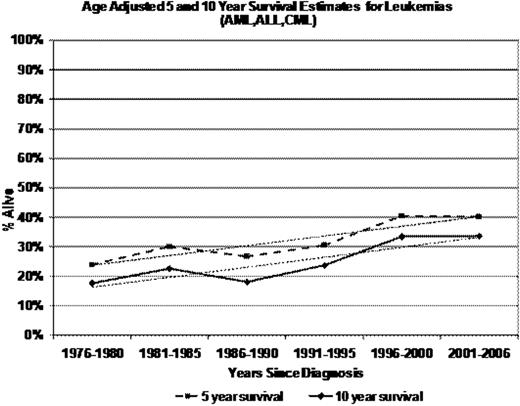Abstract
Abstract 1394
Poster Board I-416
Leukemia is the fifth most common cause of cancer death in men and seventh most common cause in women in the US. Since the advent of multi-drug chemotherapy, studies have shown improvement in survival for specific age groups. However, there have been few studies showing the impact of evolving therapies on survival for the total burden of leukemia patients. We assessed survival for an aggregate population of all patients presenting with leukemia to a regional tertiary university hospital over the past 3 decades.
To assess the magnitude of improvement in survival for patients with leukemia over the past 3 decades.
We analyzed data from the Penn State Hershey Medical Center Cancer Registry, selecting all cases diagnosed with leukemia by ICD-0-3 codes, excluding chronic lymphocytic leukemia, from Jan 1st 1976 to Dec 31st 2006. Five and ten year (yr) absolute survival rates during five time periods [group (gp) 1: 1976-1980, gp 2: 1981-1985, gp 3: 1986-1990, gp 4: 1996-2000, gp 5: 2001-2006] were obtained using conventional period analysis (PA). In addition, a period Cox Proportional Model (CPH) was fit to the data, allowing for survival risk estimates of 5 yr survival, statistical testing of time periods, and adjustments for age at diagnosis. SAS v 9.1 was used to obtain estimates, with Brenner's PERIOD macro used for PA and PHREG used for CPH.
Of 1892 patients, chronic myeloid leukemia (CML) accounted for 11%, acute myeloid leukemia (AML) 52% and acute lymphoblastic leukemia (ALL) 37%. Median age was 44 yr and mean was 40 yr with a standard deviation (SD) of 27.2 yr. Median follow up was 1.6 yr and mean was 3.9 yr with SD 5.1 yr. Approximately 13% (N=249) survived beyond 10 yr. CPH adjusted for age demonstrated an improvement in 5 yr survival among all patients with leukemia of 16%, Hazard Ratio (HR)=1.57, p=0.0002, and 16% in 10 yr survival, HR=1.6, p= 0.0001, between gp 5 and gp 1. Consistent improvements in age adjusted 5 yr survival were detected for CML (24%, HR=2.06, p=0.124), AML (17%, HR=1.53, p<0.0015) and ALL (21%, HR=1.8, p=0.01) comparing gp 5 to gp 1. Results for conventional PA were similar. There was a 19% improvement in 5 yr survival between gp 5 and gp1 for all patients with leukemia. There was greater variability by PA in the subgroups, CML(58% 5 yr), AML (7% 5 yr) and ALL (24% 5 yr).
Our analysis shows that there is a significant improvement of 16% in overall five and ten year survival rates in all leukemia patients over the last 30 years after adjusting for age at diagnosis. Subgroup analysis shows comparable improvements among the three diagnostic groups.
No relevant conflicts of interest to declare.
Author notes
Asterisk with author names denotes non-ASH members.


This feature is available to Subscribers Only
Sign In or Create an Account Close Modal